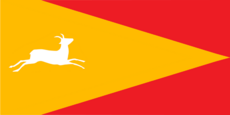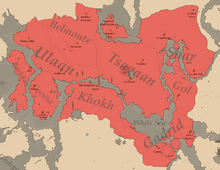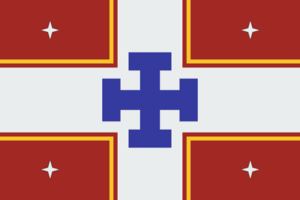Tsagaan Khanate: Difference between revisions
TrueWigParty (talk | contribs) (Created page with "{| style="float: right; margin: 0 0 0 0.5em; text-align: center; background-color: light-gray; font-size: 85%; border: 1px solid gray; padding: 0.2em; width: 250px;" ! scope="col" colspan="2" style="width: 250px; background-color: #ED1C24; font-size:125%" | The Tsagaan Khanate |- | colspan="2" |230px|alt=Tsgaani Flag Flag of Tsagaan |- | colspan="2" |230px Internal Map of Tsagaan in red, with regions labeled. |- sty...") |
No edit summary |
||
| (8 intermediate revisions by 3 users not shown) | |||
| Line 1: | Line 1: | ||
{| style="float: right; margin: 0 0 0 0.5em; text-align: center; background-color: light-gray; font-size: 85%; border: 1px solid gray; padding: 0.2em; width: 250px;" | {| style="float: right; margin: 0 0 0 0.5em; text-align: center; background-color: light-gray; font-size: 85%; border: 1px solid gray; padding: 0.2em; width: 250px;" | ||
! scope="col" colspan="2" style="width: 250px; background-color: #ED1C24; font-size:125%" | The Tsagaan Khanate | ! scope="col" colspan="2" style="width: 250px; background-color: #ED1C24; font-size:125%" | The Tsagaan Khanate | ||
| | |||
|- | |- | ||
| colspan="2" |[[File:Tsagaanflag.png|230px|alt=Tsgaani Flag]] Flag of Tsagaan | | colspan="2" |[[File:Tsagaanflag.png|230px|alt=Tsgaani Flag]] Flag of Tsagaan | ||
|- | |- | ||
| colspan="2" |[[ | | colspan="2" |[[File:TSAGAAN as of 29-1-2025.png|thumb|220x220px]]Internal Map of Tsagaan in red, with regions labeled. | ||
|- style="text-align: left;" | |- style="text-align: left;" | ||
| style="width: 72px;" |'''Population''' | | style="width: 72px;" |'''Population''' | ||
| | | 2 citizens | ||
|- style="text-align: left;" | |- style="text-align: left;" | ||
| '''Demonym''' | | '''Demonym''' | ||
| Tsagaani | | Tsagaani | ||
|- style="text-align: left;" | |||
| '''Culture''' | |||
| Tsagaani, Mistense | |||
|- style="text-align: left;" | |- style="text-align: left;" | ||
| '''Location''' | | '''Location''' | ||
| Central Cinder | | Central Cinder | ||
|- style="text-align: left;" | |- style="text-align: left;" | ||
| ''' | | '''Government''' | ||
| [[wikipedia:Elective monarchy|Absolute Elective Monarchy]] | |||
|- style="text-align: left;" | |||
| '''Great Khan''' | |||
| Khan Vita de Marirreguera | | Khan Vita de Marirreguera | ||
|- style="text-align: left;" | |- style="text-align: left;" | ||
| Line 23: | Line 30: | ||
|} | |} | ||
'''Tsagaan''' ([[wikipedia:Help:IPA/Mongolian|/tsaː.gaanː]]/), officially the '''The Tsagaan Khanate,''' and commonly referred to as '''The Khanate,''' is a [[wikipedia:Khanate|Khanate]] located in the near-spawn area and central Cinder. It was founded on August 27th of the year 2023 by TrueWig Khan. The capital of Tsagaan is Yurtbatar, located in the center of the Khanate. Tsagaan borders Cauldra in the north,[[Sanéa|Sanéa]] to it's east, and Ashannar and the Noguhn Horde to the south-west. | '''Tsagaan''' ([[wikipedia:Help:IPA/Mongolian|/tsaː.gaanː]]/), officially the '''The Tsagaan Khanate,''' and commonly referred to as '''The Khanate,''' is federal subject in [[Mistensia]], a[[wikipedia:Khanate|Khanate]] located in the near-spawn area and central Cinder. It was founded on August 27th of the year 2023 by TrueWig Khan. The capital of Tsagaan is Yurtbatar, located in the center of the Khanate. Tsagaan borders Cauldra in the north,[[Sanéa|Sanéa]] to it's east, and Ashannar and the Noguhn Horde to the south-west. | ||
== Etymology == | == Etymology == | ||
| Line 31: | Line 38: | ||
=== Prehistory === | === Prehistory === | ||
[[File:Wig Khan.png|thumb|300x300px|TrueWig Khan, first Great Khan of Tsagaan|left]] | |||
Tsagaani history begins with TrueWig Khan, whose presence became known in late August 2023 after Belmontese scouts found a collection of yurts in the valley below them. On September 9th, Adrarian officials reported that Tsagaan had moved into a Testifikan village in the nearby Taiga forest. Tsagaan informed Adraria that they had no intention of further expansion into the forest, marking the first time that the Khanate would engange with another nation in an official capacity. Tsagaani forces then forcefully relocated the villagers across lake Tung-Ak, after which they burned the occupied village. Tsagaan would then begin a program of "reeducation" for the imported Testifikans, in an effort to convert them to the Tsagaani way of life. | Tsagaani history begins with TrueWig Khan, whose presence became known in late August 2023 after Belmontese scouts found a collection of yurts in the valley below them. On September 9th, Adrarian officials reported that Tsagaan had moved into a Testifikan village in the nearby Taiga forest. Tsagaan informed Adraria that they had no intention of further expansion into the forest, marking the first time that the Khanate would engange with another nation in an official capacity. Tsagaani forces then forcefully relocated the villagers across lake Tung-Ak, after which they burned the occupied village. Tsagaan would then begin a program of "reeducation" for the imported Testifikans, in an effort to convert them to the Tsagaani way of life. | ||
TrueWig Khan would also begin his tradition of taking spiritual journeys during this time, during which the Khan would leave the Khanate for several days. TrueWig would appoint a Tur-Khan to run the Khanate during his absences. | TrueWig Khan would also begin his tradition of taking spiritual journeys during this time, during which the Khan would leave the Khanate for several days. TrueWig would appoint a Tur-Khan to run the Khanate during his absences. | ||
=== Raid of Belmonte === | |||
Cultural tensions between the north-oriented and settled Town of Belmonte and the south-oriented nomadic Tsagaan manifested itself in a Tsagaani raid against the town. On September 22nd TrueWig Khan would send a demand of tribute to the king of Belmonte. Records show the demands included large sums of ores and cattle. The King of Belmonte would deny the Khan's demand, causing the Khanate to begin preparations for the raid. During this time, the King of Belmonte would flee the city, never to be seen again. When the Tsagaani forces entered the city they were met with a volunteer brigade from the [[ Aranna|Lysoborian Host.]] It was during this battle that the Tsagaani chief of war, Baudilla, would distinguish himself as one of the most skilled military leaders in the region. After effective use of hit and run tactics, the Lysborian regiment would retreat, and surrender the city to Tsagaan. | |||
Tsagaan would then begin converting Belmonte's Testifikan population to the nomadic lifestyle, much like they had done with the Testifikans from the Taiga village. Tsagaan would also destroy Belmonte's connection to the PISS road, separating the city from is northern roots. During the raid, Tsagaan would also capture and imprison Vita de Marirreguera, who had traveled north from the town of Anneimd to defend Belmonte, of which they were closely related. Much like the Testifikans, Vita would be converted to the nomadic lifestyle. From this point onward, Anneimd would de-facto be part of Tsagaan, though retained its nominal independence. | |||
=== The TrueWig Period === | |||
The annexation of Belmonte would place Tsagaan as the foremost military power in central Cinder. When Ascëan migrants fled from Aranna, they would request the permission of the Khan to settle to Tsagaan's east. This would be the beginning of Tsagaan's informal overlordship of Ephesus, which would last until the establishment of the Principate of Messenia. | |||
Also during the period, the former town of Belmonte would fall into ruin. Damaged from the raid, it's once great walls would crumble and a earthquake would bury much of the lower city. The TrueWig period would see the formation of the Tsagaani court, with Vita de Marirreguera serving as the nation's head of diplomacy, called the Elci. Baudilla would also cement himself as the head of the Tsagaani war machine, and would serve this position until his rebellion on February 9th, 2024. | |||
=== The Cauldro-Tsagaan War === | |||
The town of Belmonte, Anneimd, and the Commune of Covilhã were all closely economically and culturally related before the arrival of Tsagaan. The annexation of Belmonte and de-facto integration of Anneimd posed a great threat to Covilhã, the last of the 3 brother nations. This caused Covilhã to willingly give itself to the Kingdom of Cauldra, trading it's sovereignty for protection. This would be the beginning of the tension between Tsagaan and Cauldra, which would eventually spill over into outright war on the 11th of December. Despite being heavily outnumbered, the Tsagaani attack on Covilhã succeeded due to superior organization and poor logistics on the Cauldran side. | |||
The victory at Covilhã completely exhausted Cauldran forces, which caused them to sue for peace with the Treaty of Covilhã, which ceded the city Covilhã to Tsagaan as a vassal. Cauldran faliure in this war would become one of the causes for the Cauldran Revoultion, which ousted the king and brought about the first revolutionary state. For Tsagaan, the war would cement them as one of Cinder's foremost military powers, which caused neighboring nations, such as those in the south, to form military alliances in the hope of defending against the Tsagaani threat. | |||
=== The Post-War Decline === | |||
Already evident before the war with Cauldra, the Great Khan's mental capacity was declining. It it theorized that he contracted some form of Alzheimer's disease [[wikipedia:Alzheimer's disease|Alzheimer's disease]], though an official diagnosis was never given. The Khan's mental decline left him unable to run the Khanate efficiently, which caused Vita de Marirreguera to increasing take over the day-to-day running of Tsagaan. This period would begin a shift in Tsagaan's foreign policy, with Marirreguera changing the Khanate to become a more peaceful state. This would mark a notable increase in cooperation with former enemies, such as [[ Cauldra|Cauldra]], and an overall decrease in Tsagaan's power projection. | |||
The change in direction greatly upset members of the military. Notably, Chief of War Baudilla would frequently complain about the loss of Tsagaan's warrior culture and the perceived weakness of the aging TrueWig. This would prompt Baudilla to spark a rebellion in the Ulaan region on the 9th of February. The leadership crisis would then cause Marirreguera to formally declare himself Khan, naming himself Khan Vita de Marirreguera. The rebellion would result in a victory for Khan Vita's forces, which forced Baudilla to seek refuge in Aranna. Shortly after the rebellion's conclusion, TrueWig Khan would pass away. | |||
=== The Khan Vita Period === | |||
This currently ongoing period in Tsagaani history has been marked by much of the same policies seen during the post-war decline, with an increased focus on isolationism. | |||
== Government and politics == | |||
The Tsagaan Khanate is an absolute monarchy, meaning all governing decisions are the responsibility of the Khan, a title currently held by Khan Vita de Marirreguera. In order to assist the Khan with governance, the Khan typically appoints a council that is made of experts in particular areas of government. | |||
Historically, the two most important positions on the council have been Chief of War and Elci, though the importance of both positions has declined with Tsagaan's increasing isolation and avoidance of violence. Additionally, the title of Tür Khan was a temporary title given to singular people of the Khan's trust in order to rule the Khanate during the absence of the legitimate ruler. | |||
== Geography == | |||
=== Physical Geography === | |||
Tsagaan's physical landscape is dominated by large open plains. These plains are broken up by the Mondego River, which flows from the Mondego lakes to the west. Medium to small sized yurt settlements dot the open plains, which are connected by horse tracks that have formed dirt roads over time. | |||
Northern Tsagaan is also home to large hills and mountains, part of the Cauldran mountain range. | |||
=== Political Geography === | |||
Tsagaani land is divided up into 9 subdivisions. The divisions are: | |||
* Belmonte | |||
* Burkhan | |||
* Covilhã | |||
* Khokh | |||
* Gird | |||
* Gol | |||
* Shar | |||
* Ulaan | |||
* Yurtbatar | |||
== Culture == | |||
[[File:Flag Mistense.png|thumb|Flag of the Mistense people]] | |||
Tsagaani culture is a mix between ethnic Tsagaani and the Mistense, who were intergrated during the Tsagaani conquests of Belmonte and Covilhã, as well as the intergration of Anneimd. | |||
=== Religion === | |||
The official state religion of Tsagaan is Pyrannic-Tengrism, of which the Khan is the highest interpreter. Due to this, Tsagaan officially recognizes the The Pyrannic Church as the highest authority on religion. | |||
In reality, very few Tsagaani citizens actually practice Pyrannic-Tengrism. Instead, the classical decentralized Tengrism is still widely practiced across Tsagaan. This belief focuses on the divinity of nature and the natural order, as well as nomad culture. The central deity of Tengrism is the Great Tengri, who is believed to be the god the of the sky and patron of the Tsagaani people. | |||
In Pyrannic-Tengrism, Great Tengri is considered to be an aspect of Pyr. | |||
[[Category:Nations]] | |||
Latest revision as of 01:15, 19 May 2025
| The Tsagaan Khanate | ||
|---|---|---|
 Flag of Tsagaan Flag of Tsagaan
| ||
 | ||
| Population | 2 citizens | |
| Demonym | Tsagaani | |
| Culture | Tsagaani, Mistense | |
| Location | Central Cinder | |
| Government | Absolute Elective Monarchy | |
| Great Khan | Khan Vita de Marirreguera | |
| Religion | Tengrism | |
Tsagaan (/tsaː.gaanː/), officially the The Tsagaan Khanate, and commonly referred to as The Khanate, is federal subject in Mistensia, aKhanate located in the near-spawn area and central Cinder. It was founded on August 27th of the year 2023 by TrueWig Khan. The capital of Tsagaan is Yurtbatar, located in the center of the Khanate. Tsagaan borders Cauldra in the north,Sanéa to it's east, and Ashannar and the Noguhn Horde to the south-west.
Etymology
The word "Tsagaan" roughly translates to the word "white". Due to a lack of written records, the exact reasoning and origin for this name is unknown, and Tsagaani locals report no knowledge on the subject.
History
Prehistory

Tsagaani history begins with TrueWig Khan, whose presence became known in late August 2023 after Belmontese scouts found a collection of yurts in the valley below them. On September 9th, Adrarian officials reported that Tsagaan had moved into a Testifikan village in the nearby Taiga forest. Tsagaan informed Adraria that they had no intention of further expansion into the forest, marking the first time that the Khanate would engange with another nation in an official capacity. Tsagaani forces then forcefully relocated the villagers across lake Tung-Ak, after which they burned the occupied village. Tsagaan would then begin a program of "reeducation" for the imported Testifikans, in an effort to convert them to the Tsagaani way of life.
TrueWig Khan would also begin his tradition of taking spiritual journeys during this time, during which the Khan would leave the Khanate for several days. TrueWig would appoint a Tur-Khan to run the Khanate during his absences.
Raid of Belmonte
Cultural tensions between the north-oriented and settled Town of Belmonte and the south-oriented nomadic Tsagaan manifested itself in a Tsagaani raid against the town. On September 22nd TrueWig Khan would send a demand of tribute to the king of Belmonte. Records show the demands included large sums of ores and cattle. The King of Belmonte would deny the Khan's demand, causing the Khanate to begin preparations for the raid. During this time, the King of Belmonte would flee the city, never to be seen again. When the Tsagaani forces entered the city they were met with a volunteer brigade from the Lysoborian Host. It was during this battle that the Tsagaani chief of war, Baudilla, would distinguish himself as one of the most skilled military leaders in the region. After effective use of hit and run tactics, the Lysborian regiment would retreat, and surrender the city to Tsagaan.
Tsagaan would then begin converting Belmonte's Testifikan population to the nomadic lifestyle, much like they had done with the Testifikans from the Taiga village. Tsagaan would also destroy Belmonte's connection to the PISS road, separating the city from is northern roots. During the raid, Tsagaan would also capture and imprison Vita de Marirreguera, who had traveled north from the town of Anneimd to defend Belmonte, of which they were closely related. Much like the Testifikans, Vita would be converted to the nomadic lifestyle. From this point onward, Anneimd would de-facto be part of Tsagaan, though retained its nominal independence.
The TrueWig Period
The annexation of Belmonte would place Tsagaan as the foremost military power in central Cinder. When Ascëan migrants fled from Aranna, they would request the permission of the Khan to settle to Tsagaan's east. This would be the beginning of Tsagaan's informal overlordship of Ephesus, which would last until the establishment of the Principate of Messenia.
Also during the period, the former town of Belmonte would fall into ruin. Damaged from the raid, it's once great walls would crumble and a earthquake would bury much of the lower city. The TrueWig period would see the formation of the Tsagaani court, with Vita de Marirreguera serving as the nation's head of diplomacy, called the Elci. Baudilla would also cement himself as the head of the Tsagaani war machine, and would serve this position until his rebellion on February 9th, 2024.
The Cauldro-Tsagaan War
The town of Belmonte, Anneimd, and the Commune of Covilhã were all closely economically and culturally related before the arrival of Tsagaan. The annexation of Belmonte and de-facto integration of Anneimd posed a great threat to Covilhã, the last of the 3 brother nations. This caused Covilhã to willingly give itself to the Kingdom of Cauldra, trading it's sovereignty for protection. This would be the beginning of the tension between Tsagaan and Cauldra, which would eventually spill over into outright war on the 11th of December. Despite being heavily outnumbered, the Tsagaani attack on Covilhã succeeded due to superior organization and poor logistics on the Cauldran side.
The victory at Covilhã completely exhausted Cauldran forces, which caused them to sue for peace with the Treaty of Covilhã, which ceded the city Covilhã to Tsagaan as a vassal. Cauldran faliure in this war would become one of the causes for the Cauldran Revoultion, which ousted the king and brought about the first revolutionary state. For Tsagaan, the war would cement them as one of Cinder's foremost military powers, which caused neighboring nations, such as those in the south, to form military alliances in the hope of defending against the Tsagaani threat.
The Post-War Decline
Already evident before the war with Cauldra, the Great Khan's mental capacity was declining. It it theorized that he contracted some form of Alzheimer's disease Alzheimer's disease, though an official diagnosis was never given. The Khan's mental decline left him unable to run the Khanate efficiently, which caused Vita de Marirreguera to increasing take over the day-to-day running of Tsagaan. This period would begin a shift in Tsagaan's foreign policy, with Marirreguera changing the Khanate to become a more peaceful state. This would mark a notable increase in cooperation with former enemies, such as Cauldra, and an overall decrease in Tsagaan's power projection.
The change in direction greatly upset members of the military. Notably, Chief of War Baudilla would frequently complain about the loss of Tsagaan's warrior culture and the perceived weakness of the aging TrueWig. This would prompt Baudilla to spark a rebellion in the Ulaan region on the 9th of February. The leadership crisis would then cause Marirreguera to formally declare himself Khan, naming himself Khan Vita de Marirreguera. The rebellion would result in a victory for Khan Vita's forces, which forced Baudilla to seek refuge in Aranna. Shortly after the rebellion's conclusion, TrueWig Khan would pass away.
The Khan Vita Period
This currently ongoing period in Tsagaani history has been marked by much of the same policies seen during the post-war decline, with an increased focus on isolationism.
Government and politics
The Tsagaan Khanate is an absolute monarchy, meaning all governing decisions are the responsibility of the Khan, a title currently held by Khan Vita de Marirreguera. In order to assist the Khan with governance, the Khan typically appoints a council that is made of experts in particular areas of government.
Historically, the two most important positions on the council have been Chief of War and Elci, though the importance of both positions has declined with Tsagaan's increasing isolation and avoidance of violence. Additionally, the title of Tür Khan was a temporary title given to singular people of the Khan's trust in order to rule the Khanate during the absence of the legitimate ruler.
Geography
Physical Geography
Tsagaan's physical landscape is dominated by large open plains. These plains are broken up by the Mondego River, which flows from the Mondego lakes to the west. Medium to small sized yurt settlements dot the open plains, which are connected by horse tracks that have formed dirt roads over time.
Northern Tsagaan is also home to large hills and mountains, part of the Cauldran mountain range.
Political Geography
Tsagaani land is divided up into 9 subdivisions. The divisions are:
- Belmonte
- Burkhan
- Covilhã
- Khokh
- Gird
- Gol
- Shar
- Ulaan
- Yurtbatar
Culture

Tsagaani culture is a mix between ethnic Tsagaani and the Mistense, who were intergrated during the Tsagaani conquests of Belmonte and Covilhã, as well as the intergration of Anneimd.
Religion
The official state religion of Tsagaan is Pyrannic-Tengrism, of which the Khan is the highest interpreter. Due to this, Tsagaan officially recognizes the The Pyrannic Church as the highest authority on religion.
In reality, very few Tsagaani citizens actually practice Pyrannic-Tengrism. Instead, the classical decentralized Tengrism is still widely practiced across Tsagaan. This belief focuses on the divinity of nature and the natural order, as well as nomad culture. The central deity of Tengrism is the Great Tengri, who is believed to be the god the of the sky and patron of the Tsagaani people.
In Pyrannic-Tengrism, Great Tengri is considered to be an aspect of Pyr.